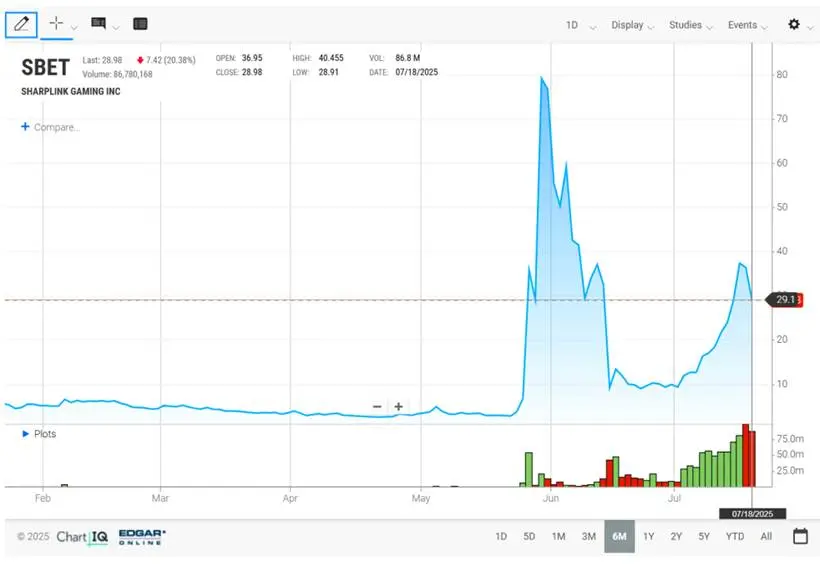Manipulating SharpLink, Unveiling the Behind-the-Scenes Player A.G.P. in the Stock-Coin Frenzy
Original Author: Zz, ChainCatcher
Original Editor: TB, ChainCatcher
On July 15, 2025, a shocking news ignited the market: SharpLink, a game company on the verge of delisting, announced that it would use all the $413 million raised in a week to buy Ethereum. The capital market responded with the most fervent enthusiasm—according to data from Investing and Nasdaq, its stock price surged by 528% in six months and soared by more than 150% in a single month.

However, SharpLink's comeback story is just the tip of the iceberg. Almost simultaneously, a broader capital alchemy was quietly unfolding across different industries: a traditional consumer goods company (Upexi) ingeniously incorporated SOL tokens into its reserves through sophisticated bond design; a crypto mining giant (Bitdeer) successfully connected with traditional Wall Street capital; and a Canadian cutting-edge tech company (BTQ) leveraged regulatory loopholes to raise tens of millions from American investors.
From 'penny stocks' on the brink of delisting to stable consumer brands, from crypto-native enterprises to cross-border tech upstarts. When people tried to find the mastermind behind the scenes, the spotlight this time did not fall on Goldman Sachs or J.P. Morgan, but on a previously inconspicuous mid-sized investment bank: A.G.P. (Alliance Global Partners).
As the orchestrator or key participant in all these deals, A.G.P. has perfected this model. On the SharpLink project alone, based on its commission rate, it likely earned over $8 million in commissions within a week, and this was just the beginning of its $6 billion grand plan.
While Wall Street giants were building compliance bridges for institutional clients, A.G.P. took a more aggressive path: transforming various listed companies into 'crypto proxy stocks' en masse and sitting at the table as the one designing the game rules.
Batch Manipulation of SharpLink and Other U.S. Listed Companies' Crypto Treasury Construction
A.G.P. demonstrated its manipulation techniques through four cases. Its model is not a standardized strategy but highly customized: identifying client pain points and market hotspots, flexibly using tools like ATM agreements to design fee structures that maximize its own benefits for each transaction.
The most typical case is SharpLink. On May 27, 2025, SharpLink announced: completed a $425 million private placement, led by Consensys, with Ethereum founder Joseph Lubin as chairman. According to the 8-K filing, A.G.P. served as the exclusive placement agent, earning a 5-7% underwriting fee. However, the main course was the subsequent ATM agreement.
Here, the ingenuity of the ATM agreement needs explanation. Traditional stock offerings are like dumping a large bucket of water into the market, inevitably causing a sharp drop in stock price. The ATM agreement is entirely different; it's like installing a smart faucet for the company: when the stock price rises, the investment bank accelerates the faucet, selling millions of shares in a single day; when the stock price corrects, it immediately turns off the faucet or slows issuance, waiting for a better time; company management can decide to pause or restart the entire plan at any time.
Specifically, the core of the ATM agreement is batch directional issuance. Unlike traditional offerings that require setting price and quantity at once, ATM allows companies to raise funds in batches under optimal market conditions. Each issuance is controlled within 1-2% of daily trading volume, hardly attracting market attention. This high-sell-low-stop strategy protects the stock price while maximizing financing efficiency.
From the fee structure, according to the S-3/A filing on June 14, A.G.P. divided the $6 billion ATM quota into three tiers: the first $1 billion at 2.5%, the next $1 billion at 2.0%, and the rest at 1.75%. At an average of 2.1%, A.G.P. could earn about $126 million from this. This mechanism creates a bond of interest: A.G.P. is motivated to maintain the stock price for continuous issuance, while SharpLink gains a long-term, stable financing source.
Besides SharpLink, another innovative case by A.G.P. is Upexi. On July 17, A.G.P. designed a $150 million convertible bond for the consumer goods company Upexi. Investors used SOL tokens as collateral to buy the bonds, enjoying a 2.0% annual interest rate and the right to convert into stock at $4.25. For Upexi, this was equivalent to acquiring SOL reserves at low cost, both raising funds and hopping on the crypto bandwagon. Crypto funds holding SOL locked in traditional stock market upside. A.G.P., as the exclusive placement agent, earned underwriting fees from this deal.
Also noteworthy is that on June 18, A.G.P. participated as a joint bookrunner in the $330 million convertible bond issuance by crypto mining company Bitdeer Technologies. By serving industry players, A.G.P. not only earned direct underwriting income but also established a position in the crypto mining financing niche.
The case of BTQ Technologies, a post-quantum cryptography company, further demonstrates A.G.P.'s regulatory arbitrage capability. On July 11, by utilizing Canada's LIFE exemption mechanism (a pathway allowing simplified approval for small-scale financing), A.G.P. raised CAD 40 million for this company from American investors. In return, A.G.P. received a 7% cash commission and warrants equivalent to 2.5% of the financing amount. This cross-border regulatory arbitrage yielded a total return rate close to 10%, far exceeding the 5-7% commission level of traditional IPO business.
A.G.P. Has a Golden Touch
A.G.P.'s business model is not a simple copy-paste but, like an experienced hunter, chooses the most precise and effective 'weapon' for different types of 'prey' and their environments. Each case selection is tightly coupled with its unique financial solution design.
SharpLink was on the brink of disaster. Its business revenue plummeted, and its stock price was low, a typical company in desperate need of a 'strong medicine' to survive. For such targets, management and shareholders are most receptive to radical solutions, willing to pay high commissions for a lifeline, providing A.G.P. with the greatest operational and profit space.
SharpLink's transformation needed a continuous, self-reinforcing story. One-time traditional offerings couldn't achieve this. The flexibility of the ATM (At-The-Market) agreement allowed A.G.P. to turn financing into a series: 'Announce buying crypto to push up the stock price, then immediately sell shares at high prices in the secondary market; after raising money, buy more crypto, push up the stock price again'—this 'financing-buy crypto-stock price rise' cycle can only be perfectly realized with ATM, which can issue shares anytime, in any amount, turning the company into a 'perpetual money-printing machine' under A.G.P.'s control.
Upexi is a traditional consumer goods company, not a distressed enterprise. Choosing it was to prove that A.G.P.'s model could empower any stable company eager for a 'crypto narrative,' thereby greatly expanding its business boundaries.
Traditional companies are wary of directly using cash reserves to buy highly volatile crypto assets. A.G.P. designed SOL token-collateralized convertible bonds: simply put, A.G.P. found a group of wealthy crypto funds to buy $150 million in Upexi bonds with cash. The clever part is, these funds also had to put up their SOL tokens as additional collateral.
For Upexi, it gained $150 million in cash and could claim 'we have SOL reserves,' making the stock price story instantly more appealing, without spending a dime. For crypto funds: their plan was 'earn steady interest, wait for a surge.' First, secure a stable 2% annual interest, with the real goal being to convert bonds into stock at the agreed $4.25 low price once Upexi's stock took off, then sell high for big profits.
And A.G.P.? It's the 'matchmaker.' Whether Upexi's stock rises or falls, as the middleman, it pockets a hefty underwriting fee upfront.
Bitdeer Technologies is itself a giant in crypto mining,不缺加密故事. A.G.P. chose it to prove it could not only transform 'outsiders' but also serve 'insiders,' acting as a 'bridge' connecting the crypto world with traditional Wall Street capital.
For crypto-native enterprises like Bitdeer, the core pain point in financing is gaining 'trust endorsement' from traditional financial markets. A.G.P.'s participation as a joint bookrunner in its convertible bond issuance essentially used its licensed investment bank credibility to enhance Bitdeer's credit, making it easier to gain recognition and funds from mainstream institutional investors. This move aimed to establish A.G.P.'s authoritative position in the core track of crypto infrastructure financing.
The key feature of BTQ Technologies, a Canadian post-quantum cryptography company, is its 'non-U.S.' jurisdiction. A.G.P. chose it to showcase its ability to navigate complex cross-border regulations, a highly specialized skill.
Because directly attracting U.S. capital to invest in a small Canadian tech company is cumbersome. A.G.P. precisely utilized Canada's LIFE exemption mechanism, a regulatory shortcut that bypasses full prospectus requirements, quickly and cost-effectively introducing U.S. capital to BTQ. This was essentially a clever 'regulatory arbitrage,' with A.G.P. leveraging its mastery of different countries' financial rules to create excess returns and efficiency unmatched by traditional IPOs.
Behind the Golden Touch: Wall Street's Thirst for Money and Radical Change
In the post-pandemic macroeconomic environment, traditional small and mid-cap companies generally face growth bottlenecks. When traditional paths to improve core business become exceptionally difficult, they urgently need a new story that can instantly ignite market enthusiasm. Cryptocurrencies, especially Ethereum and Bitcoin, provide the sexiest, most easily understood 'growth narrative' by the capital market today.
Rather than spending years on difficult business transformations, directly announcing cryptocurrency purchases—this radical 'balance sheet revolution' can overnight reshape a mediocre company into a tech pioneer, the fundamental driver behind the rise of the crypto-stock linkage model.
The core contradiction in the current market is the significant time gap between regulatory actions (e.g., by the U.S. SEC) and market speculation speed.
The SEC and other agencies have indeed repeatedly expressed 'serious concerns' about massive shareholder dilution, misleading marketing, and potential market manipulation. However, in the first half of 2025, these warnings remained largely at the level of risk alerts and framework discussions, not yet translated into specific, enforceable regulations that could comprehensively prohibit such operations.
From issuing warnings to legislation to effective enforcement is a lengthy process. It's this regulatory vacuum that A.G.P. and other investment banks have keenly captured, seeing it as a fleeting golden window. Rather than 'defying the wind,' it's more like 'harvesting the last wave of红利 before the storm hits.'
Market participants' strategies perfectly confirm that everyone is accelerating before this wave's window closes:
As a pioneer, A.G.P. knows this feast is time-limited. Thus, it's expanding its ATM agreement business at an unprecedented pace, extending clients from tech companies to retail, manufacturing, biotech, and other traditional sectors. The logic is clear: complete as many deals as possible before the regulatory 'gate' falls, securing profits.
When B. Riley Securities, TD Cowen, and others formed specialized teams to enter, it precisely shows that all of Wall Street recognizes this as a special 'what's not forbidden is allowed' period. First-mover advantage is fading, and while commission rates may drop due to competition, the certainty of this wave's红利 attracts everyone.
Upgrade and Risk: The 'Noah's Ark' When the Storm Comes?
When the crypto market enters a bear market, or regulatory crackdowns finally land, this leverage and narrative-supported狂欢 will end. Then, dried-up financing channels, significant asset impairments, stock crashes, and class actions will form a 'perfect storm.'
Simply betting A.G.P.'s future on the success or failure of current crypto-stock linkages perhaps underestimates this investment bank's core capability. Reviewing its cases reveals that A.G.P.'s true 'golden touch' is not a Midas-like magic but a replicable, highly flexible methodology.
For A.G.P., the real 'Noah's Ark' is not any specific asset or business but this methodology itself. When the 'crypto-stock linkage' wave recedes, it will almost certainly apply this playbook to the next风口, whether real-world asset tokenization (RWA), carbon credits, or any other new领域 with 'narrative potential' and 'regulatory ambiguity.'
Data from S3 Partners shows that SharpLink's short interest surged by 300% in the past month, indicating 'smart money' has sniffed out danger, quietly exiting before the countdown ends, betting on this狂欢's eventual collapse.
